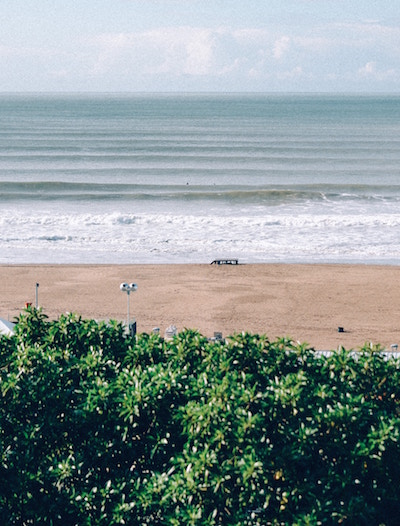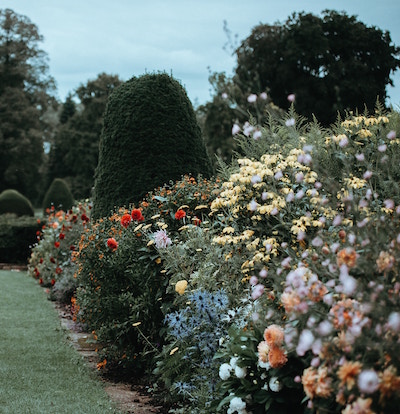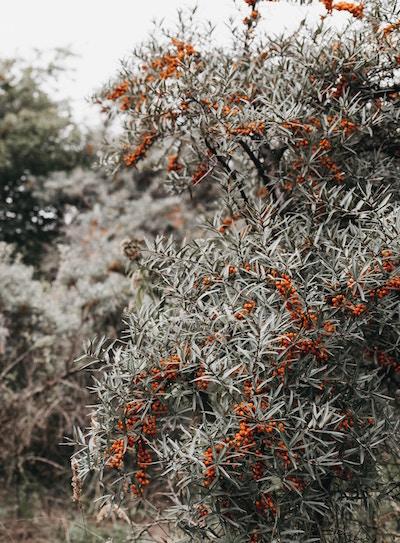Here is a simple 5-points analysis method followed by suggestions:
1. Evaluate the difficulty level of the project

First, it is necessary to evaluate the plantation difficulty level.
We suggest evaluating the strength and frequency of the wind, then the presence of humus (earth). Among the following situations, note the one that best represents the proposed planting location:
a) Strong and permanent wind, rocky soil or tuff (rocky cape without vegetation nor any protection of the prevailing wind);
b) Regular wind with occasional gusts. Presence of some low plants with shallow or sandy soil. Flat or hillside terrain;
c) Occasional wind with gust, presence of medium sized plants, bent by the prevailing wind. Normal or sandy soil. Some natural protection (trees, mountains or buildings);
d) Weak but steady wind, occasional gust. Presence of plants of good size and several natural protections (microclimates).
Case "a" is the most difficult. Without added protection (wall, greenhouse or dense trellis on the prevailing wind side) and without added humus, it will be difficult to grow anything. The constant wind prevents plants from concentrating their energy on growth, and a rare and poor soil deprives the plant of water and essential nutrients.
The other cases ("b", "c" and "d") are good or excellent starts and can be improved to become fertile and flourishing places. Here are some techniques to increase the potential of a place:
2. Install a vegetal or inert material windbreak
A windbreak does not completely cut the wind but slows it on a good distance. Planting should be favored on the protected side of the prevailing wind, relatively close to the windbreak, especially if it is not wide or high.
There are two types of windbreaks useful for planting: windbreaks made of inert materials and vegetal windbreaks. For the first ones, here are some examples:
- A building (house, shed, greenhouse) is an excellent windbreak;
- A section of wall with a greenhouse, a dense fence (40% occupied area or more) or a trellis provide protection on a limited but useful height;
- A cliff, rocks or other natural or modified geological formations (terraces, galleries, borders) blocking the prevailing wind make a huge difference.
Vegetal windbreaks have the advantage of being potentially larger, wider, cheaper and long lasting. They have the disadvantage of being slow to set up (especially if one starts from scratch) and can experience hazards (broken, dried trees).
In our opinion, the effects of vegetal windbreaks are more interesting in the long term since plants produce humus, retain moisture, attract pollinating fauna and, of course, multiply! We can observe the concrete effects in seaside terrains that are dense with forests, for example in Métis-sur-Mer. Most of the land benefits from a situation that is close to the ideal for planting because there are wind-protected sections everywhere.

Some suggestions of windbreak plants adapted to the Gaspe peninsula:
Broadleaf

- Serviceberry (fruit tree)
- Sea buckthorn (shrub, berries, wind resistant, multiplies easily)
- Aronia / black chokeberry (shrub, berries)
- Hawthorn (small tree)
- Alder (shrub, grows in poor soil, enriches the soil)
- White birch (tree)
- Caragana (shrub, wind resistant, multiplies easily)
- Honeysuckle (shrub)
- Dogwood (shrub, grows in poor soil, multiplies easily)
- Cotoneaster (shrub)
- Silverberry / wolf-willow (shrub, wind-resistant, multiplies easily)
- Bur oak (big tree)
- Sugar maple (big tree)
- Amur maple (shrub)
- Green Ash (large tree)
- Winged spindle (shrub)
- Alpine currant (shrub, wind resistant, multiplies easily)
- Lilac (shrub to tree)
- American elm (big tree)
- Poplar (large tree, some varieties growing rapidly)
- Crabapple (choose a rustic variety)
- Potentilla (dense shrub)
- Ninebark (shrub, wind resistant)
- Wild rose (shrubby, some wind-resistant, dense)
- Willow (large tree, some shrubby varieties and growing rapidly)
- Mountain-ash / Rowan (small tree)
- Staghorn Sumac (shrub, multiplies easily)
- Basswood / Linden (big tree)
- Viburnum (shrub)
Conifers
- White cedar (big tree)
- Spruce, native varieties (large tree)
- Larch (no needles in winter)
- Red, white, woodland Pines (large sizes)
- Balsam and other hardy firs
- Creeping (shrub) or conical (narrow trees) junipers
- Cedar hedge cultivar (narrow to wide possible, generally high)
3. Use mulch and drip irrigation
One of the harmful effects of the wind, especially if it is constant, is the drying up of the plants. In a windy place, drying can be prevented by using a ground cover to prevent water evaporation. Several solutions can be considered:
- plastic canvas;
- geotextile;
- cardboard;
- mulch (choose preferably hardwood chips, otherwise cedar);
- any vegetable matter, compostable, non-acidifying. Ex: fallen leaves, thin wooden planks and damp, mowing residues, etc.

Obviously, it will be necessary to keep the mulch material in place by fixing it with weights such as rocks, bricks, branches, etc. In the case of waterproof mulch (plastic or cardboard), make sure that rainwater can flow in the vicinity and reach the roots of the plant.
The advantage of biodegradable material such as hardwood mulch or fallen leaf mulch is that it brings fertility by breaking down in addition to maintaining a beneficial microbial life for the plant.
If you have access to a water source (use a rainwater harvesting barrel), you can also install a drip irrigation system to prevent drought after planting. Perforated hoses are now available at reasonable prices in hardware and garden stores. These hoses can be placed installed the mulch.
4. Plant hardy and adapted fruit varieties
The effect of wind on plants can not easily be quantified. Generally, the Gaspe peninsula seashore are zoned 4a, or even 4b in Baie-des-Chaleurs (see Canadian hardiness zone for more information). Theses zones are calculated primarily from minimum winter temperatures and do not take into account the local wind factor. However, we recommend zone 3 or 2 plants in places with strong winds, to prevent the wind chill freezing the buds of a plant or causes drying. Here are some cultivar suggestions among the usual fruit trees:
Apple tree (prefer dwarf or semi-dwarf)

- Battleford
- Goodland
- Norkent
- Norland
- Parkland
- Rosybrook
- September Ruby
- Zone 3 varieties are also recommended
Pear tree (usually all "hardy" pear trees)
- Golden Spice
- John
- Sainte-Sophie
- Savignac
- Summercrisp
- Ure
Plum tree
- japanese-american hybrids (Brookgold, Brookred, Pembina, Kahinta, Waneta)
- some Europeans (Mirabelle, Mont-Royal)
- Black and American plum trees (Bounty, native)
Cherry tree
-
Sour cherry (tart or “pie” cherries like Montmorency, North Star, etc.)
Dwarf cherry (Romance series)
Blueberry
- Northland
- Northblue
Other hardy berries: Saskatoon berries, sea buckthorns, chokeberries, wild cherries, cranberries, black currants, strawberries, raspberries, goji, red / white currant, arctic kiwifruit, blackberry, white elderberry, cranberrybush, wintergreen. Prefer cultivars hardy for zone 3 or zone 2.
5. Technicalities on vegetal windbreaks
In the case of planting a shelterbelt, trees are planted closer to one another than in a normal plantation (aiming for twice the normal density), to obtain a wall effect of very dense branches and leaves. The idea is to spread 60-80% of the wind energy and lift it above the windbreak.
Generally, a windbreak of several staggered rows (or zig-zag, the next row covering the "holes" of the first row) is provided. The more rows, the more effective the windbreak will be. Also, a long windbreak must be provided for the windbreak effect to be solid. Generally, we aim at a windbreak ten times wider than high. An ideal form is a triangle, with the largest trees at the center and the smaller ones at the ends. With such an arrangement, the protected area is 20 to 30 times the height of the highest (central) tree. Ex: a 10' high tree in the center with several rows of shrubs, over 100' wide will protect a space of 200' to 300' long ..!
A shelterbelt with both broadleaved and coniferous trees may be more resilient and beneficial than a windbreak with only one of two types (from an ecosystem point of view). Conifers, however, are superior to hardwoods for their windbreak effect during the winter as they remain dense. The effect of winter deciduous trees is diminished by the loss of leaves, but it remains useful.
Finally, here are some general suggestions for your windbreak:
- Prefer seedlings (1-2 years), as they generally have a better recovery after planting than larger ones (and are cheaper!). Over several years, a young planted tree will generally catch up with, or even grow larger than, a tree planted at a later age.
- Plant a lot, a lot of plants, densely. You may have a loss on quantity, but wind plants will protect others and growth will be assured. Some plants will stand out because of competition effects.
- Plant species that are already in the landscape or that have already been proven in a similar environment. Plant trees or shrubs that you have dug up yourself on the seaside (dig out early in the spring or late in the fall, when there are no leaves in the trees);
- Plant several varieties and several types of plants at a time: broadleaves, conifers, shrubs, trees, etc. You will have a much better chance of finding the varieties that are comfortable and grow fast.
- Combine techniques: fencing, shrub hedge, coniferous area, geotextile mulch, cardboard, chip mulch and leaves, irrigation, etc. Plant cuttings of willow, blackcurrant (easiest) directly into the mulch to densify, sow seeds, etc.
- Enjoy free tree distribution days. They usually happen in May (Month of the trees and forests in Quebec). Many native hardwoods and conifers are generally available.

